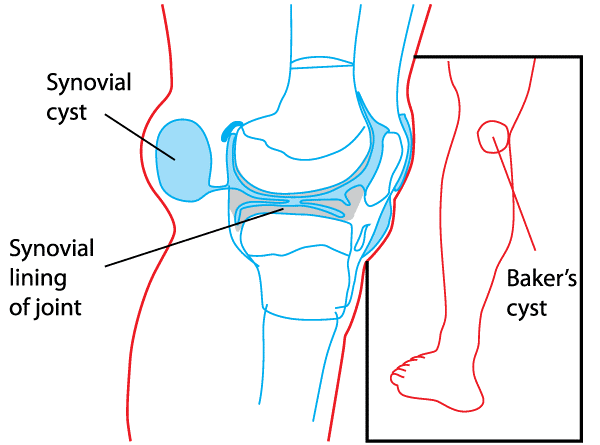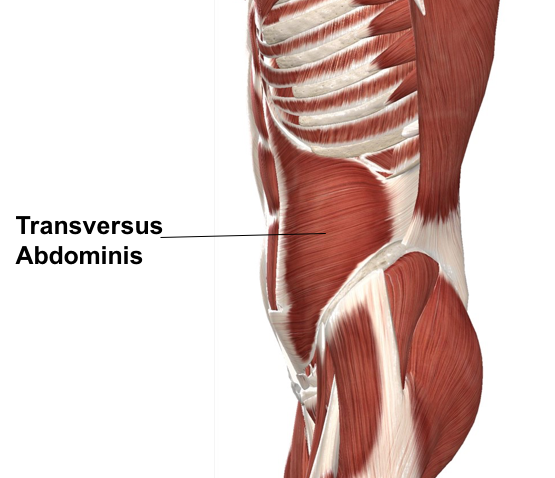Benefits of jumping rope exercise
Table of Contents
Introduction:
- Jumping rope exercise, often known as skipping rope, is a physical activity in which you jump over a rope as it passes beneath your feet. It is a popular and efficient kind of cardiovascular exercise that people of all ages and fitness levels may participate in.
- Jumping rope is a fantastic aerobic exercise for heart health.
- It works particularly well for injury prevention and lower-body power training.
- Jumping rope can be practiced along with other forms of exercise, and you can modify your technique according to your degree of fitness.
- There are various reasons to adore jumping rope, as well as numerous advantages that will motivate you to incorporate it into your routine. This dated exercise equipment offers an affordable, transportable kind of cardio and whole-body training.
- Additionally, it can enable you to work out vigorously and sweatily without having to leave your house, which makes it a superb option in these epidemic times.
- Jumping rope may also help with coordination, explosive power, agility, and a number of other major sports advantages. Another major benefit is that it’s simply simple and enjoyable.
What is jumping rope?
- Jumping over a rope as it is continually spun over the head and beneath the feet is known as jumping rope.
- The exercise called “jumping rope” is swinging a rope around your body and leaping over it as it passes beneath your feet. Since your heart rate is raised by continual movement, it counts as cardiovascular exercise.
- Jump roping is a total-body exercise that may build your muscles and enhance your cardiovascular health. Additionally, it’s enjoyable. Both adults and kids may get a great full-body exercise with jumping rope. Along with strengthening your muscles and enhancing your cardiovascular system, it will also boost weight reduction by burning calories.
- The ideal cardio activity is jumping rope. It promotes cardiovascular fitness, warms up the body, strengthens the muscles, and burns a lot of calories quickly. Jumping rope helps improve one’s speed, agility, coordination, and balance.
- The sport of jumping rope, commonly referred to as skipping rope, is well-liked all throughout the world. Basic jumping rope includes spinning a rope over the head and back to the feet while holding one end in each hand. When it reaches the feet, it is leaped over, flipped around to face the back, and then thrown back up towards the head. Jumping rope is a great exercise for calorie burning and muscular development. Anyone at any age who does not have any movement restrictions or issues with the knees, ankles, or feet can perform it.
About the jump ropes:
- Jump ropes come in a variety of styles. Most have handles made of wood or plastic. Jump ropes range in length, but most are 9–10 feet (2.7–3 meters) long. By trimming off a little portion of the rope and knotting or retying the handle end of the jump rope, many jump ropes may be modified. A jump rope should be laid on the ground and its two handles should be grasped to check its size. The handles should only extend to the armpits if it is the appropriate size.
- Jumping rope has a straightforward fundamental principle. But there are many other ways you may utilize the jump rope, depending on your fitness objectives.
- For instance, some individuals do quick jump roping to improve their speed and agility, while others concentrate on explosive power-building exercises like the double-under, which involves jumping up and swinging the rope two times under your feet before you land again. Others explore with more unusual, dance-like moves while using the jump rope as a creative release.
- Jumping rope may be an excellent exercise on its own, as a warm-up or cool-down before weight training, or as a part of an interval-style workout that includes bodyweight exercises.
- Jumping rope training can be tailored to your specific fitness objectives and tastes. You can change the intensity by varying the speed and height of your jumps, the duration of your workout, and the inclusion of alternative jump patterns. It is a versatile and portable workout that can be done practically any place, making it an easy way to stay active.
- It is critical to warm up before beginning your jumping rope exercise and to pay attention to your body. Begin with shorter intervals and progressively increase your workout duration and intensity as your fitness level improves. Remember to have proper form, stay hydrated, and jump on an appropriate surface to reduce the impact on your joints.
How to do jumping rope exercise:
Most likely, you are familiar with the fundamentals of jumping rope. However, a refresher on the appropriate form will help you get the most out of it while minimizing your chance of injury. How to jump rope is as follows:
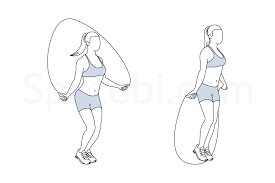
- Stand tall with your back straight, shoulders relaxed, and gaze forward.
- Jump rope handles should be held in each hand when you begin with the rope behind your feet.
- To activate your core, squeeze your abdominals.
- Swing the rope overhead by making a slight circular motion with your wrists.
- As the rope approaches your feet, slightly bend your knees and jump. Stay on the balls of your feet and try to land softly.
- Repeat.
Benefits of Jumping Rope Exercise:
Jumping rope, a classic childhood activity, is not only enjoyable but also an incredibly effective form of exercise. It offers a wide range of benefits that promote cardiovascular health, burn calories, improve coordination, and enhance overall fitness. In this article, we will explore the numerous advantages of incorporating jumping rope into your fitness routine.
Jumping rope is an incredibly beneficial exercise that can positively impact your overall health and well-being. From cardiovascular health and calorie burning to improved coordination and cognitive function, it offers a wide range of advantages. Whether you’re a fitness enthusiast or someone looking for an efficient exercise option, consider incorporating jumping rope into your routine and experience the remarkable benefits it has to offer.
Jumping rope exercise offers a wide range of benefits that contribute to improved physical fitness, mental and overall well-being:
1. Aids in Establishing and Maintaining an Exercise Routine
We are all aware of how important regular exercise is for preserving both physical and mental health. However, for many of us, the biggest challenge is continuing our efforts after making a significant New Year’s resolution or “summer bod” preparation.
Jump rope removes many of the obstacles that prevent us from creating routines, which is why it’s so successful for doing so.
Time: Many of us don’t have enough time each day to work out for an hour. Jumping rope is a very effective and efficient workout that takes very little time. Jumping rope for 15 minutes can burn up to twice as many calories as running for 15 minutes.
Space / Portability: rope does not require a gym and is portable. The weather does not affect it either. You can always find a place to jump rope, whether it be inside or outside. So it’s simple to keep up your regimen when traveling.
Enjoyment: You can learn many jump rope maneuvers and techniques to keep things interesting and challenging for yourself.
2. An Effective Cardio Workout for Losing Weight and calorie burning:
Jumping rope is a high-intensity, full-body workout that can burn a significant amount of calories in a short period. It helps create a calorie deficit, aiding in weight loss and body fat reduction.
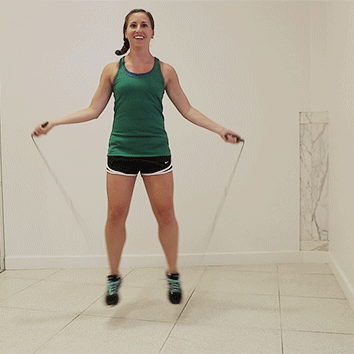
Jumping rope for only two ten-minute workouts can result in a 200-calorie calorie burn. A week of daily practice can help you burn more than a thousand calories. An average 20-minute run burns between 100 and 150 calories.
You may burn between 200 and 300 calories every day if you practice for just 15 minutes. Since 3,500 calories are equal to one pound of fat, losing a pound by jumping every day will only take roughly 12 days. An easy commitment for such spectacular outcomes is fifteen minutes.
During High-Intensity Interval Training (HIIT) exercises, a jump rope can also be used. These exercises transform your body into a calorie-burning machine by using a 2:1 ratio of exertion to rest. In half the time it takes to do a fairly strenuous workout, you’ll burn more fat as your metabolism increases.
Jumping rope is also good for your heart. There is a reason why the American Heart Association launched a movement focused only on jumping rope. It has been demonstrated that jumping rope lowers inflammation and reduces the risk of heart disease. Jogging is a less effective cardiovascular exercise than jumping rope.
3. Brain Stimulation
Exercise is known to benefit the brain. However, you know that exercises that require both mental and physical effort, such as slacklining, ballroom dancing, or jumping rope, have a greater impact on cognitive performance than exercises that only need physical effort, such as using a treadmill or stationary bike.
The best brain exercises need synchronization, rhythm, and strategy. Jumping rope requires coordination, spatial awareness, and precision, so your brain exercises with you. Your cognitive functioning is strengthened by exercise that requires mental attention. When you jump rope, your brain’s two hemispheres are both working. Your brain can create new neural connections by improving your skills through new techniques. In fact, daily practice may help to preserve or even improve memory.
So, set a goal for yourself to try some jump rope stunts the next time you are jumping rope. It appears that they are quite beneficial for your brain.
4. Increased Agility & Speed:
The quick, explosive movements involved in jumping rope exercise.
Every day, spend a few minutes skipping rope to make your feet lighter. When you jump rope on your toes, your body and mind collaborate to create “neural muscular adjustments” that maintain you steady.
In essence, skipping rope enhances your balance, agility, and coordination by keeping your attention continuously on your feet, even when you’re not aware of it.
Jump rope exercise offers numerous benefits for improving agility and speed. Here are some key ways in which jump rope can help enhance these areas of athletic performance:
- Footwork and Coordination: Jumping rope requires precise footwork and coordination. As you jump over the rope, you need to time your jumps correctly and maintain a consistent rhythm. This repetitive motion challenges your coordination skills and helps improve your ability to synchronize movements between your upper and lower body. The development of precise footwork and coordination translates directly into improved agility and speed in other athletic activities.
- Quickness and Reaction Time: Jump rope exercise can enhance your quickness and reaction time. The fast-paced nature of jumping rope requires you to react quickly to the movement of the rope and adjust your jumps accordingly. This constant adaptation and responsiveness develop your ability to react swiftly in sports or activities that demand quick changes in direction or speed.
- Balance and Proprioception: Jump rope exercise requires balance and proprioception, which is your body’s sense of its position in space. As you jump and maintain stability, you develop better balance and proprioceptive abilities. This improvement in balance and body awareness contributes to enhanced agility and speed by providing a solid foundation for controlled movements and quick changes in direction.
- Versatile Training Tool: Jump rope exercise is a versatile training tool that can be customized to target specific aspects of agility and speed. You can vary the intensity, speed, footwork patterns, and jump techniques to focus on specific areas of improvement. For example, incorporating side-to-side movements, double unders (two rotations of the rope per jump), or lateral jumps can specifically enhance lateral agility and speed.
5. Full-Body Workout
There is no need to select between arm day and leg day; while you’re doing it, including a core workout. Your entire body gets stronger as you jump rope, including:
muscles in the lower extremities, including the glutes, hamstrings, and calves
muscles of the upper extremities, including the triceps, biceps, chest, shoulders, and back muscles
core muscles like the obliques and abs.
Tendons, ligaments, and joints are all supported by these muscles. In addition, leaping on the ground repeatedly enhances bone density. You may profit from a lifetime of well-being by increasing your body’s strength on a regular basis.
Jump rope exercise offers a multitude of benefits for achieving a full-body workout. Incorporating jump rope into your fitness routine can target and engage various muscle groups:
- Legs and Lower Body: Jumping rope primarily engages the muscles in your legs, including the calves, quadriceps, hamstrings, and glutes. These muscles are continuously activated to propel your jumps and maintain stability. The repetitive impact of jumping rope helps strengthen and tone these muscle groups, contributing to improved lower body strength and endurance.
- Core Strength: Jump rope exercise requires core stabilization to maintain balance and control during jumps. Your abdominal muscles, including the rectus abdominis, obliques, and transverse abdominis, work together to stabilize your torso and maintain an upright posture. This constant engagement helps strengthen and tone your core muscles, contributing to improved core strength and stability.
- Shoulders and Arms: The motion of swinging the jump rope involves your shoulders and arms. As you rotate the rope, your deltoid muscles in the shoulders and the muscles in your upper arms, such as the biceps and triceps, are engaged. While the intensity may not be as high as dedicated arm exercises, jump rope can still provide some toning and endurance benefits for these muscle groups.
- Back and Posture: Jump rope exercise can help improve back strength and posture. Proper form and technique during jumps require you to maintain an upright posture and engage the muscles in your back, including the erector spinae and the muscles in your upper and mid-back. Consistently practicing jump rope with good posture can contribute to improved back strength and overall postural alignment.
- Full-Body Coordination: Jump rope exercise challenges your coordination skills as you coordinate the movement of your arms, legs, and core while jumping with the rope. This full-body coordination enhances overall body awareness and improves the communication between different muscle groups, leading to improved motor control and movement efficiency.
6. Stronger Feet & Ankles
Your feet have hundreds of intricate structures, and wearing shoes inhibits them by “binding” them in ways that might cause injury. Without relying on a shoe to keep you upright, developing that foot-to-earth connection helps to strengthen the stabilizer muscles in your feet and ankles.
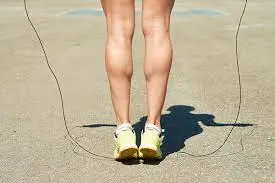
Jump rope can strengthen your ankles and feet. Jumping rope exercises can have a positive effect on ankle and foot strength:
- Increased stability: Jumping rope requires balance and coordination, which helps strengthen the muscles around the ankles and feet. When you perform repetitive jumping movements, the muscles responsible for stabilizing the ankle are activated and strengthened, which increases overall stability.
- Ankle flexibility: Jump rope exercises involve ankle flexion and extension, which can help improve ankle flexibility. Regular exercise can increase range of motion, allowing better mobility and reducing the risk of ankle stiffness and injury.
- Muscle strength: Jumping rope activates muscles in the legs and calves, including the gastrocnemius, soleus and tibialis anterior. These muscles play an important role in supporting the ankles and foot arches. With regular skipping rope exercise, these muscles are challenged and strengthened, improving the overall strength and stability of the ankles and feet.
- Arch support: A jump rope can help improve arch strength and stability. The repetitive impact forces of jumping promote engagement of the inner leg muscles that support the arch of the foot. This can be especially beneficial for people with flat feet or weak arches, as jump rope exercises target these specific areas.
- Injury prevention: Strengthening your ankle and leg muscles with jump rope training can help reduce the risk of common injuries such as sprains and strains. Stronger muscles and improved stability improve joint control and alignment, reducing the likelihood of accidents during physical activity.
- Rehabilitation and recovery: Jump rope can be used as part of ankle and foot rehabilitation programs. Under the guidance of a health professional or physical therapist, jumping rope exercises can help strengthen weakened muscles, improve range of motion, and promote recovery from certain ankle or foot injuries.
7. Improve Bone density and strength:
The repetitive impact of jumping rope helps strengthen bones and increases bone density, reducing the risk of osteoporosis and improving overall bone health.
Bone density evaluates the strength of your bones; if you have more minerals in your bones, such as calcium, they are less brittle and less prone to shatter. A higher bone density can also lessen the risk of osteoporosis later in life, especially in girls and women.
Due to the repetitive contact with the ground with each jump, jumping rope enhances bone density. Lower bone density is associated with higher death rates. It’s crucial to increase your skeletal strength now, before it starts to decline later in life, typically around age 50.
Jumping rope can improve bone density and strength. Here’s how jumping rope exercises can have a positive effect on bone health:
- Weight-bearing exercise: Jumping rope is a weight-bearing exercise, which means your body has to support its weight against gravity. Weight-bearing exercises have been shown to stimulate bone remodeling and increase bone density. The landing effect when jumping with a skipping rope stimulates the bones, and promotes bone growth and strengthening.
- Effects on the bones of the lower body: Jumping mainly affects the bones of the lower body, including the bones of the lower leg and foot. The repetitive impact forces during jump rope exercises promote bone adaptation and strengthen the bones in these areas. It can be especially useful in areas prone to osteoporosis, such as the hips, knees, and ankles.
- Whole Body Engagement: Although the lower body is primarily engaged with the jump rope during jumping, the upper body, including the arms and shoulders, also plays a supporting role. Engaging the upper body increases the overall weight-bearing effect, further stimulating an improvement in bone density throughout the body.
- Progressive Overload: It is important to gradually increase the intensity and duration of jumping rope exercises over time to improve bone density and strength. Gradual overload, involving a challenge beyond the normal capacity of bones and muscles, promotes bone adaptation and growth.
8. Endless New Skills To Learn
Jump roping is a never-boring exercise to do every day. There is always a fresh objective to work towards. To leap higher (and burn more calories), for instance, you might want to increase your revolutions per minute. Alternately, to improve your skipping effectiveness and increase stamina, set an endurance objective. Even learning to jump rope and dance simultaneously is possible.
There are countless jump rope techniques to learn. It’s thrilling enough to pick up enough speed to advance from a single jump to a double under when the rope passes beneath your feet twice every jump. Just try to picture yourself being able to execute a boxer’s skip like a real heavyweight. You’ll soon be gliding like a butterfly if you practice every day.
9. Customizable:
With jump roping, you may choose a certain style you prefer and make it your own, unlike other forms of exercise. Spinning quickly. Wheel leaping in China. Dutch double. juggling a soccer ball while jumping rope. Evidently, there are countless ways to have fun with a jump rope.
10. Versatility and variety:
Jumping rope can be done anywhere, anytime, and by people of different fitness levels. Whether you’re at home, in a park, or at the gym, you can easily incorporate jump rope into your workout routine. It can be adjusted to suit your fitness level by varying the intensity, duration, and jump styles.
Jump rope offers a great deal of versatility and variety, which are significant benefits for incorporating it into your fitness routine. Here are some specific advantages in terms of versatility and variety:
- Exercise options: The skipping rope allows many different exercises in addition to traditional jumping. You can add different techniques, footwork patterns, and jumping styles to add variety and challenge to your workouts. This includes high knees, side-to-side jumps, single-leg jumps, double dips (twice around the rope per jump), crossovers, and more. These variations target different muscles and provide a versatile workout.
- Fitness levels: The jump rope can be adapted to people of different physical levels. Beginners can start with simple jumps and gradually progress to more advanced techniques. Whether you’re a beginner looking for a low-impact workout or a seasoned athlete looking for high-intensity cardio, you can customize a jump rope to fit your needs.
- Interval training: A jump rope is an excellent tool for interval training, where high-intensity training and rest periods alternate. Adding intense jumps and short recovery periods to your intervals can improve your cardiovascular fitness, burn calories, and boost your metabolism. This form of exercise saves time and is effective in losing fat.
- Cross-training: Jump rope can be used as a cross-training tool to complement other forms of exercise. Whether you’re a runner, lifter, or participate in another sport, adding a jump rope to your routine can improve your overall fitness. It helps improve coordination, flexibility, endurance, and cardiovascular capacity, which can improve performance in other activities.
- Circuit training: Jump rope can be integrated into circuit training, where you do a series of exercises with minimal rest. It allows you to combine strength training with jump rope intervals, providing a complete full-body workout that improves both strength and cardiovascular fitness.
- Workout variety: One of the benefits of jumping rope is that it helps prevent exercise boredom. Its versatility allows you to create infinite jump rope workouts by varying the intensity, duration, and footwork patterns and adding other exercises. This tension keeps your workouts interesting and exciting, helping you stay motivated and on track with your workout routine.
- Rehabilitation and injury prevention: A jump rope can be used as a rehabilitation tool to treat minor injuries or as a preventative measure. This can help improve ankle stability, strengthen calf muscles, and promote lower body mobility. If you have an injury or medical condition, it’s important to consult a doctor before adding jump rope to your rehabilitation program.
11. Portable and cost-effective:
- Portability: Jump ropes are lightweight and compact, making them extremely portable. You can easily carry a jump rope in your bag or suitcase, making it a convenient exercise option for travelers, busy individuals, or those who prefer exercising outdoors.
- Affordability: Jump ropes are relatively inexpensive compared to other fitness equipment. You can find high-quality jump ropes at affordable prices, making them a cost-effective investment for your fitness routine.
12. Prepare for Additional Activities
Although jumping rope is one of the best aerobic exercises, you don’t have to include it in every aspect of your workout. Jump roping is a fantastic add-on exercise to other activities.
Jump rope to get your body warmed up before beginning another physical activity. It is a rapid approach to increase heart rate and blood circulation.
13. Jumping Rope Improves Your Heart Health & Improves Cardiovascular Function:

When it comes to raising your heart rate, skipping rope is the finest cardio. Skipping rope exercises at a high intensity have been shown to strengthen the heart and reduce the risk of heart disease and stroke.
Jumping rope is beneficial to more than just your muscles and bones. Additionally, it supports heart and lung health. By training many muscles, the complex workout immediately boosts your heart rate. Jumping rope may also be more effective than other types of cardio.
Skipping rope is beneficial to your cardiovascular system and heart health since it gets your heart pounding. Jumping rope, for instance, can raise your V02 Max, which is a gauge of how much oxygen you can consume when exercising. The greater a person’s VO2 max, the greater their cardiovascular endurance.
Regular jumping rope can improve your heart’s efficiency by increasing the flow of oxygenated blood to your muscles and organs. It strengthens the cardiac muscle and enhances its capacity to pump blood. This can result in a lower resting heart rate and less stress on the heart during physical exercise over time. Jumping rope is a fantastic aerobic exercise that gets your heart rate up and improves cardiovascular endurance.
14. Mental Benefits of Jumping Rope:
Skipping rope at a moderate pace can help with anxiety and despair. Exercising improves blood circulation in both the body and the brain. Skipping can help your mental health by generating endorphins, a hormone believed to alleviate depression symptoms.

- Better Mental Health: Jumping rope is not only physically demanding but also mentally engaging. It requires focus, concentration, and coordination, which can enhance mental alertness, cognitive function, and mind-body connection. Regular exercise is linked to a decreased risk of anxiety and depression. Jump roping lowers stress because it demands concentration and releases endorphins. Even 10 minutes a day of exercise might elevate your mood. To get some sunshine and a serotonin boost, try jumping rope outside. The companionship and sense of community you can experience if you decide to join a jump rope club could make you happy. A good night’s sleep is aided by that gratifying post-workout fatigue. The correlation between adequate, deep sleep, increased energy, and emotional fulfillment is strong.
- Stress relief and mental well-being: Engaging in physical activity like jumping rope releases endorphins, which are known as “feel-good” hormones. This can help reduce stress levels, elevate mood, and improve overall mental well-being. Jumping rope can also serve as a form of meditation or mindfulness, allowing you to focus on your movements and clear your mind.
- Can be meditative: Jumping rope, despite its intensity, can be a highly contemplative sport. Active meditation is when you concentrate your full concentration on maintaining a steady rhythm—and nothing else. She adds that you can also use it to play a mindfulness game by shutting your eyes and taking 30 seconds to simply listen to the sound of your rope or other noises and sensations in your surroundings.
- Improves spatial awareness: Jumping rope on a regular basis might help you enhance your spatial awareness. That’s because when you’re jumping rope, you have to continually be aware of what’s in front, behind, and to the sides of you—especially if you’re in a small space; otherwise, you may hit neighboring things with your rope. Jumping rope improves spatial awareness, which can help you become a better athlete. Being spatially aware and flexible may be highly helpful in a variety of situations.
15. Rope Jumping Can Increase Your Concentration:
Skipping rope exercise improves concentration because it improves balance and coordination. Jump rope has a unique potential to develop both the left and right hemispheres of the brain. It will improve your alertness, memory, and attention.
Jump rope can have a positive effect on focus and concentration. Here’s how to increase your focus by adding jump rope exercises to your routine:
- Mind-Body Connection: Jumping rope requires coordination and timing, which promotes a strong mind-body connection. When practicing this activity, you must synchronize your movements and maintain a rhythm that promotes focus and concentration on the task.
- Better cognitive function: Regular physical exercise, including jumping rope, has been shown to improve cognitive function. Exercise increases blood flow to the brain, delivering oxygen and nutrients that support optimal brain function, including focus and attention.
- Release of neurotransmitters: Jumping rope stimulates the release of various neurotransmitters such as dopamine, serotonin, and norepinephrine in the brain. These chemicals play a role in regulating mood, attention, and concentration, increasing focus.
- Mental break and recovery: Taking a break from mentally demanding tasks and doing physical activity, such as jumping rope, can provide mental recovery. This allows you to get away from distractions, clear your mind, and return to work or study more focused and refreshed.
16. Skipping rope may make your skin glow.
Skipping rope accelerates your heart rate, increasing blood circulation throughout your body. Because this activity aids in the quicker release of toxins, it contributes to a beautiful complexion! One of the nicest glows to get is a post-workout glow!
Jumping rope can promote glowing skin by promoting better circulation, detoxification, enhanced nutrient delivery, cleansing pores through sweat, reducing stress, reducing collagen production, and increasing hydration. The increased circulation and lymphatic stimulation during jump rope training helps transport oxygen, nutrients, and essential compounds to the skin cells while removing toxins and impurities. This, along with the sweat-inducing nature of the activity, can result in brighter, more radiant skin. Additionally, reducing stress and potentially stimulating collagen production can further improve the skin’s appearance, while staying hydrated supports the skin’s optimal moisture and healthy glow.
17. Jumping rope increases body flexibility
Flexibility and agility are two advantages of skipping rope. As you leap, your muscles are both strong and relaxed. For this reason, it is included in an athlete’s training plan. It promotes agility, or the ability to move quickly and easily, while also improving strength, stamina, flexibility, and hand-eye coordination. So it’s no surprise that everyone, from sportsmen to gymnasts, boxers, tennis players, and celebrities, uses the skipping rope.
18. Jumping rope exercise improves pulmonary function
Another advantage of skipping rope is that it boosts lung capacity while also improving respiration and blood circulation. Jumping rope can help improve lung function by improving cardiovascular fitness and activating the respiratory system.
- Aerobic Exercise: Jumping rope is a form of aerobic exercise that increases your heart rate and requires constant cardiovascular effort. By engaging in aerobic activity, such as jumping rope, you strengthen the heart and lungs, improving their ability to deliver oxygen to the body’s tissues.
- Increased Lung Capacity: Jumping rope includes rhythmic breathing patterns that can help increase lung capacity. When you do aerobic exercise that requires deep, controlled breathing, your lungs are trained to take in more oxygen and get rid of carbon dioxide more efficiently.
- Respiratory muscle strength: Jump rope exercises activate the muscles involved in breathing, including the diaphragm and intercostal muscles. These muscles are strengthened and treat with regular jumping rope exercises that improve breathing muscles and strength.
- Oxygen utilization: Jumping with a skipping rope increases the body’s need for oxygen, which stimulates the body’s respiratory system to improve oxygen utilization. This process can increase gas exchange in the lungs and improve overall respiratory function.
- Increased ventilation: Jump rope exercises promote increased ventilation, which refers to the amount of air exchanged during breathing. The increased speed and depth of breathing associated with jumping rope increases the flow of fresh air into the lungs, which facilitates the intake of oxygen and the removal of carbon dioxide.
- Better lung efficiency: Regular jumping rope exercises can improve lung efficiency by improving air distribution and optimizing the function of the alveoli (air sacs in the lungs). This results in more efficient gas exchange and improved overall lung function.
- Respiratory Endurance: Jumping rope requires constant cardiovascular effort and constant breathing. By doing regular rope exercises, you can improve your breathing endurance, allowing you to perform physical activities with less fatigue and better breathing control.
19. Jumping rope can reduce fatigue and boost stamina:
Jumping rope is an efficient approach to increase your overall endurance and improve the muscles you use when running without putting as much stress on your joints. It may feel exhausting, but it trains your body to strive for more and finally get rid of lethargy.
Jumping rope is a very effective exercise that can reduce fatigue and greatly improve endurance. Practicing this dynamic activity will challenge your cardiovascular system, improve oxygen delivery to working muscles and increase overall endurance. Jumping rope builds cardiovascular fitness by allowing your body to efficiently deliver oxygen and nutrients, which reduces fatigue during exercise.
In addition, the repetitive muscle contractions of jump rope training and the effect of interval training improve muscle strength in both the lower body and the upper body. As a result, regular jump rope training improves your ability to stay active longer, increases energy expenditure, and strengthens mental focus, making it a great way to reduce fatigue and improve endurance.
20. May improve your coordination:
Jump rope is a versatile exercise that offers numerous benefits, including coordination improvement. Here’s how jumping rope can help enhance coordination:
- Timing and Rhythm: Timing and rhythm are necessary while jumping rope so that the leaps match the rope’s rotation. Individuals’ capacity to synchronize motions and acquire a sense of time are both enhanced by this recurrent action.
- Hand-Eye Coordination: Jumping over the rope successfully requires deft hand-eye coordination. In order to properly time their leaps, the person must rotate the rope with their hands while watching its movement with their eyes.
- Footwork and Lower Body Coordination: Continuous leaping is required when jumping rope, which calls for good foot, ankle, and lower body coordination. To follow the beat of the rope as they jump, participants must stay balanced, alter their feet, and coordinate their motions.
- Bilateral Coordination: Jumping rope works the body’s two sides simultaneously, which improves bilateral coordination. To keep a steady jumping beat, the left and right sides of the body must cooperate, which improves general coordination.
- Proprioception and Body Awareness: The ability of the body to perceive its position and movement is referred to as proprioception. Proprioceptive talents are put to the test while someone is jumping rope since they have to continually modify their body posture, height, and landing to prevent tripping over the rope. This enhances bodily coordination and awareness.
- Cognitive Coordination: Exercises involving the jump rope can be paired with a variety of footwork patterns and techniques. As people must focus on completing the movements precisely while keeping the beat, learning and using these advanced techniques requires cognitive coordination.
Improving coordination through jump rope exercises can have a positive impact on various physical activities and sports that require precise movements, timing, and synchronization. Regular practice can enhance overall motor skills and coordination abilities.
21. Improved balance and proprioception
- Balance improvement: Jumping rope requires maintaining balance and stability while performing repetitive movements. This constant challenge to stay upright and centered helps strengthen the muscles responsible for balance, such as the feet, ankles, and calves. As you continue to jump rope, you will gradually develop better balance and stability, which can be useful in various activities and sports that require good balance.
- Improve Proprioception: Proprioception refers to your body’s ability to perceive its position in space and the relative position of its various parts. Jumping rope engages your proprioceptive system because it involves coordination and timing between your legs, arms, and rope. This heightened awareness of your body’s movements and position improves proprioception over time. You will improve your overall body control, coordination, and movement efficiency by perfecting your proprioceptive skills through jump rope training.
- Joint Stability: Jumping rope requires your joints, especially your ankles, and knees, to maintain stability and alignment during repetitive impact. This helps to strengthen the supporting structures around these joints, including ligaments, tendons, and muscles, ultimately improving joint stability. Better joint stability not only reduces the risk of injury but also improves balance and overall quality of movement.
- Core Engagement: Jumping rope requires an active core to maintain proper posture and alignment throughout the exercise. Your core muscles, including the deep stabilizing muscles of your abdomen and back, play an important role in maintaining balance and stability. Constantly activating these muscles during a jump rope exercise strengthens the core and improves your ability to maintain balance and stability in a variety of activities.
- Neurological Adaptations: Jump rope causes your nervous system to synchronize your body movements, hand-eye coordination, and timing with the rotation of the rope. This constant coordination between the brain, muscles, and sensory receptors improves neural connections and communication. Over time, your nervous system becomes more efficient at processing and integrating sensory information, improving balance, coordination, and proprioceptive skills.
22. Full-body workout engaging multiple muscle groups simultaneously:
One of the significant benefits of jump rope exercise is that it provides a full-body workout by engaging multiple muscle groups simultaneously. Here’s how to jump rope helps work various muscles throughout the body:
- Lower Body: The jump rope primarily targets the muscles of the lower body, including the calves, quadriceps, hamstrings, and glutes. These muscles work continuously during jumping and landing, providing an effective workout to strengthen and tone the legs.
- Core Muscles: Jumping rope requires core stability and control to maintain proper posture and balance throughout the exercise. Your abdominal muscles, including rectus abdominis, transversus abdominis, obliques, and lower back, play an important role in stabilizing your torso and supporting your body during jumps.
- Upper Body: Although jumping rope is primarily a lower-body exercise, it also engages the upper body muscles. Your shoulders, arms, and wrists are actively involved in controlling the movement of the rope. With each twist, your shoulders and arms rotate the rope, which helps strengthen your deltoids, biceps, triceps, and arms.
- Back muscles: When you jump and hold an upright position, your back muscles, including your back and upper and middle back muscles, are activated to support your spine and maintain proper alignment.
- Core Stabilization: Jumping rope requires core stabilization, which means that the deep stabilizing muscles of the abdomen and back are constantly engaged to maintain a steady and stable position. It improves the overall strength and stability of the core muscles. Secondary muscles: In addition to the main muscle groups mentioned above, the jump rope engages several side muscles to a lesser extent. These include muscles in the feet and ankles that help with propulsion and landing, and smaller stabilizing muscles throughout the body that help maintain balance and coordination.
Engaging multiple muscle groups simultaneously during jump rope exercises leads to an efficient and effective full-body workout. This not only helps improve muscle strength, endurance, and tone but also increases overall calorie burn and cardiovascular conditioning. The combination of the lower body, core, and upper body engagement makes jump rope a time-efficient exercise for targeting multiple areas of the body and achieving a comprehensive workout.
23. Increased Lymphatic Flow:
Jumping rope can actually promote increased lymph flow, which offers several benefits to the body. Here’s how jumping rope can positively affect lymphatic circulation:
- Lymphatic system: The lymphatic system is crucial to the body’s fluid balance and immunological response. It consists of a network of blood vessels, lymph nodes, and organs that help remove waste, toxins, and pathogens from the body.
- Lymphatic flow: Unlike the circulatory system, where the heart pumps blood, the lymphatic system relies on movement and muscle contractions to circulate lymphatic fluid. Physical exercises, including jumping rope, can facilitate the flow of lymph nodes.
- Muscle contractions: When jumping rope, the repetitive up-and-down movements and muscle contractions help pump lymph fluid through the lymph vessels. This movement helps to remove waste, toxins, and excess fluid from the body.
- Detoxification: By increasing the flow of lymph nodes, jumping rope helps eliminate toxins and waste that accumulate in the body. It can promote detoxification and improve overall health and well-being.
- Immune System Support: The lymphatic system is closely related to the immune system. Jump rope can promote lymph flow, promote immune system function, facilitate the removal of pathogens, and stimulate immune cell activity.
- Reduce Edema: Edema refers to the accumulation of excess fluid in the tissues of the body, which often causes swelling. Jump rope can help reduce swelling by improving lymph flow and facilitating the removal of excess fluid.
- Reduction of Cellulite: Cellulite is a condition characterized by the accumulation of fat under the skin, resulting in a dimpled appearance. Improved lymphatic flow through activities such as jumping rope can help reduce cellulite by promoting the removal of toxins and improving circulation in affected areas. While jumping rope can increase lymph flow, it is important to note that this is only one aspect of maintaining healthy lymph nodes. Other practices such as maintaining hydration, maintaining a balanced diet, and avoiding prolonged inactivity also support optimal lymphatic function.
24. Improve Posture by jumping rope:
Jump rope can really improve your posture. Adding jump rope exercises to your exercise routine can have a positive effect on your posture:
- Core Exercise: Jumping rope requires engaging the core muscles to maintain stability and control throughout the exercise. The core includes the abdominal, lower back, and pelvic muscles, which play a crucial role in maintaining proper posture.
- Spinal Alignment: A jump rope in good condition promotes an upright posture with the back aligned and the shoulders back. Regular exercise can help strengthen proper spinal alignment, which improves posture over time.
- Strengthening the back muscles: The repetitive jumping motion engages the back muscles, including the spinal and rhomboid muscles. Strengthening these muscles helps support the spine and maintain an upright posture.
- Shoulder Stability: Proper jumping rope technique involves relaxing and keeping your shoulders down, away from your ears. This helps improve shoulder stability and prevent the shoulders from rounding, which can contribute to poor posture.
- Postural Awareness: Jumping rope requires focus and body awareness to maintain balance and coordination. This increased awareness can extend to your daily activities, making you more aware of your posture and encouraging you to maintain good posture throughout the day.
- Better muscle balance: Jumping rope engages multiple muscle groups, including legs, core, and upper body. Regular exercise of these muscles helps create a balanced force distribution that promotes better posture.
- Balance and Stability: Jump rope tests your balance and stability as you descend and ascend with each jump. By improving balance and stability, you improve your ability to maintain proper posture in a variety of positions and movements.
25. Better Sleep:
Engaging in regular jump rope exercises can contribute to better sleep. Here’s how jumping rope can positively impact sleep quality:
- Better sleep efficiency: Jumping rope exercises can improve sleep efficiency, which is the time it takes to fall asleep compared to the total time spent in bed. Regular physical activity is associate with better sleep efficiency, which means that physically active people spend more time sleeping in bed.
- Increased sleep duration: Participating in jumping rope exercises can increase sleep duration. Studies have shown that people who exercise regularly often sleep longer and more deeply than those who are sedentary.
- Better sleep quality: Regular exercise, including jumping rope, has been link to better sleep quality. It can help people achieve deeper, more restorative sleep, waking up more refreshed and alert.
FAQs
Jumping rope is a physical activity that involves jumping across a skipping rope while maintaining a steady pace. It is a popular form of cardiovascular exercise that can be enjoy by people of all ages and fitness levels.
Jump rope training offers many benefits, including:
Cardiovascular Fitness: Jumping rope increases your heart rate, improves heart health and endurance. Weight Loss: Jumping rope is a very effective calorie burning exercise that can help you lose weight and reduce body fat.
Better coordination: The rhythmic movement of the jump rope improves coordination, balance and flexibility.
Muscle tone and strength: Jump rope training engages several muscle groups, especially in the lower body, including the calves, thighs and glutes.
Bone density: Jumping rope regularly can help improve bone density and reduce the risk of osteoporosis.
Convenience and affordability: Jump ropes are inexpensive and portable, making them a convenient exercise option that can be done almost anywhere.
Stress reduction: Jump rope workouts release endorphins that help relieve stress and improve mood. Better cognitive function: Jumping rope requires focus and coordination, which can improve cognitive function and mental acuity.
Yes, the jump rope exercise is suitable for most people. However, those with certain medical conditions, such as joint problems or cardiovascular disease, should consult their healthcare provider before starting a new exercise program. To avoid injury, it is important to start with a comfortable pace and gradually increase the intensity.
The length of the jump rope workout depends on your fitness level and goals. Beginners can start with shorter exercises of 5-10 minutes and gradually increase the duration of the exercise as their physical condition improves. Aim for at least 15-20 minutes of jumping rope to experience significant cardiovascular benefits.
For best results, incorporate jump rope workouts into your routine 3-5 times a week. This frequency allows your body to benefit from regular exercise.
There are a variety of jump ropes available, including jump ropes made of PVC, leather or steel cables. Beginners may find PVC ropes easier to handle, while more advanced jumpers may prefer steel ropes for speed and durability. Choose a rope that suits your fitness and personal preferences.
It is recommend that you talk to your doctor before starting a new exercise program, especially if you have any health problems. Also, make sure you have proper footwear and a proper jumping platform to minimize the risk of injury.
Although jumping rope focuses primarily on cardiovascular fitness, it works several muscles in the body, including the legs, core and arms. However, if your primary goal is to build muscle, you may want to add more resistance or strength training to your routine.
Jump rope training can be a fun and effective way for children to engage in physical activity. However, to avoid accidents and injuries, it is important to ensure proper supervision, use age-appropriate jump ropes and consider the child’s coordination and skill level.
Yes, jump rope exercise can enhance sports performance. It improves coordination, agility, footwork, and cardiovascular endurance, which are beneficial for a wide range of sports such as basketball, tennis, boxing, and soccer.
Jump rope exercise is a great calorie-burning activity that can contribute to overall fat loss, including reducing belly fat. However, it’s important to combine it with a balanced diet and other forms of exercise for optimal results.
Yes, Jump rope exercise is an excellent addition to a HIIT workout routine. It can be alternate with other exercises, such as bodyweight exercises or sprints, to create a challenging and effective interval training session.
Jumping rope engages the core muscles, including the abdominals and lower back, which play a significant role in maintaining good posture. Regular jump rope exercise can help strengthen these muscles, leading to improved posture over time.
Yes, jump rope exercise is a fantastic way to improve overall cardiovascular endurance, which can translate into improved endurance for other activities like running, cycling, or swimming. Incorporating jump rope into your training regimen can enhance your stamina and ability to sustain physical effort for longer durations.
Jump rope exercise can help improve ankle stability and strength as it requires balance and coordination. The repetitive jumping motion helps strengthen the muscles surrounding the ankles, reducing the risk of sprains and other injuries.
Like any physical activity, there is a potential risk of injury with jump rope exercise if not performed with proper technique or if overdone. Common jump rope-related injuries include ankle sprains, shin splints, and stress fractures. To reduce the risk of injury, ensure you have proper footwear, a suitable jumping surface, and practice good form. Start with low-impact jumps and gradually increase intensity over time.
Jump rope exercise can be an excellent addition to a cross-training routine. Its cardiovascular and full-body conditioning benefits complement a variety of other exercises, such as strength training, yoga, or sports-specific workouts. Adding jump rope sessions to your cross-training routine can enhance overall fitness and performance.
Yes, jump rope exercise can be modified for individuals with joint issues. Low-impact variations, such as performing small jumps or using a thicker, cushioned rope, can help reduce stress on the joints while still providing a cardiovascular workout. Consulting with a healthcare professional or a certified fitness trainer can provide guidance on modifying the exercise to suit individual needs.





